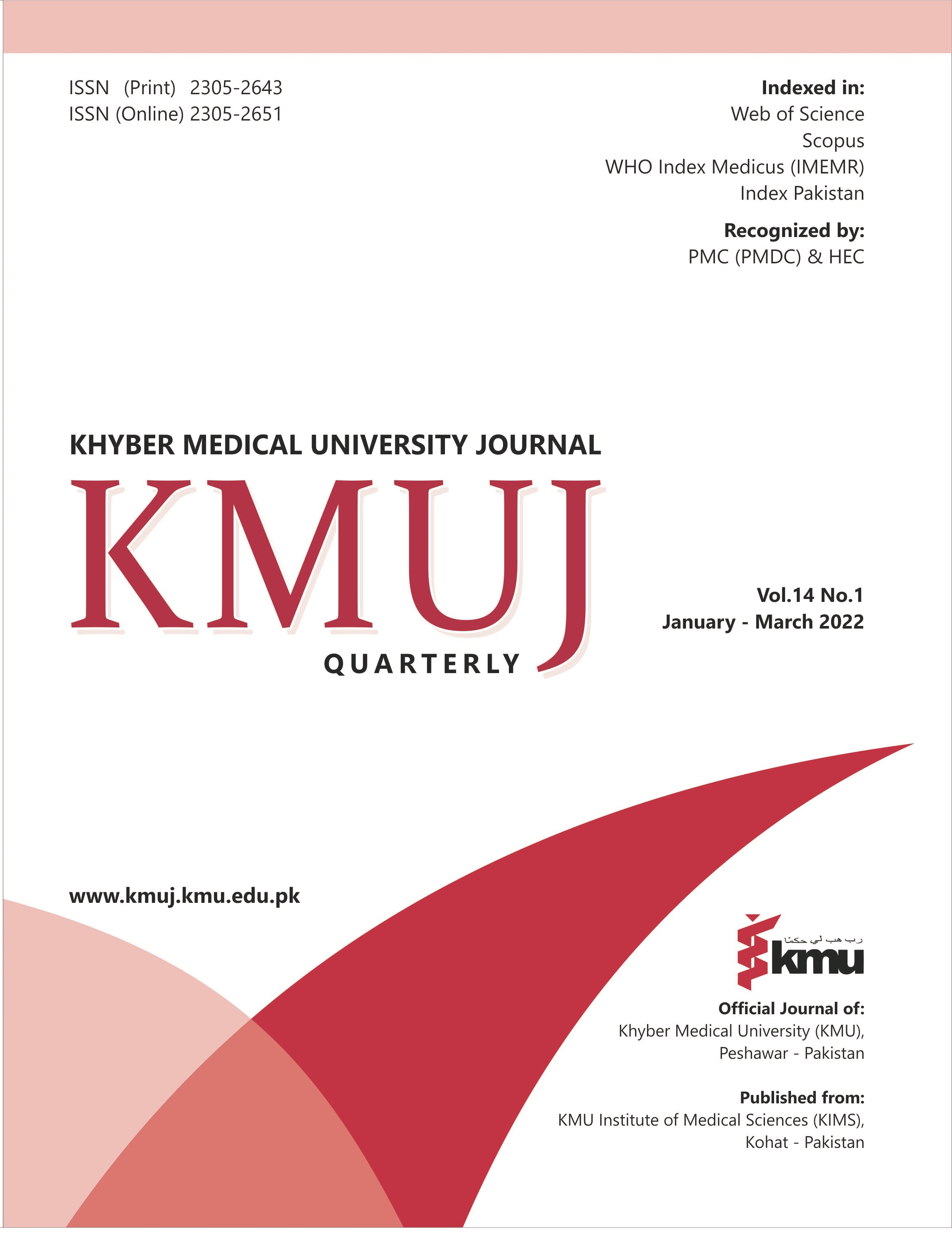STROKE IN WOMEN: TIME TO ACKNOWLEDGE SEX DIFFERENCES
Main Article Content
Abstract
Historically, the stroke incidence, prevalence and mortality have been reported to be higher in men compared to women. But this gap seems to be narrowing over time. Recent data from high income countries suggests that the incidence of stroke varies with age, and older women beyond 75 years of age, may have a higher stroke incidence compared to men.1 Additionally, women below 40 years in some South East Asian countries showed an increase in ischemic stroke incidence over time.2 Moreover, Middle East and North Africa have reported higher stroke mortality amongst females compared to males. Keeping in view this changing epidemiology, it is imperative to have a better understanding of stroke in women.
When evaluating conventional risk factors for stroke, there are certain sex differences that need special mention. Hypertension has an overall lower prevalence in women compared to men, however, its prevalence as well as its association with ischemic stroke increases in older women. Diabetes is a stronger risk factor for stroke in women compared to men, and atrial fibrillation and migraine are both more prevalent and more strongly associated with ischemic stroke in women.3
Women are in addition exposed to sex-specific risk factors which do not receive much attention. Pregnant and post-partum women have been found to be at three times higher risk of stroke compared to other young adults and this is related to a number of changes associated with these states.4 Hypertensive disorders of pregnancy not only raise the risk during pregnancy but a recent study on the Framingham cohort concluded that a history of pre-eclampsia confers a three-fold higher risk of experiencing a stroke in later life.5
Besides pregnancy, other hormonal changes also increase a woman’s stroke risk. An early menopause and a shorter reproductive lifespan have both been identified as increasing stroke risk in women.6,7 Similarly exogenous oestrogen, be it in the form of oral contraceptive pills or hormone replacement therapy, has also been shown to increase stroke risk in several studies.8,9
Stroke presentations are also more variable in women. Whereas men tend to present with the classic focal neurological deficits, women tend to present with more non-traditional symptoms like fatigue, light headedness, altered mental status etc.10 They also tend to present more often with stroke mimics. These and other reasons explain why women have longer delays in getting proper stroke care and several studies have reported worse outcomes for women.11,12
Very limited data is available on stroke in women from low and middle income countries. It is reasonable to believe that the social determinants of health would further compound the risk and outcomes for women in these areas. Lack of proper nutrition, poor pregnancy management and outcomes, multiparity and poor access to healthcare both for acute and secondary stroke prevention are important factors that are expected to affect stroke in women. Future research should focus on risk factors unique to women in these countries. In addition, awareness should be created amongst physicians so as to screen women early for potential risk factors and address them in a timely manner.
Article Details
Work published in KMUJ is licensed under a
Creative Commons Attribution 4.0 License
Authors are permitted and encouraged to post their work online (e.g., in institutional repositories or on their website) prior to and during the submission process, as it can lead to productive exchanges, as well as earlier and greater citation of published work.
(e.g., in institutional repositories or on their website) prior to and during the submission process, as it can lead to productive exchanges, as well as earlier and greater citation of published work.
References
Howard VJ, Madsen TE, Kleindorfer DO, Judd SE, Rhodes JD, Soliman EZ, et.al. Sex and race differences in the association of incident ischemic stroke with risk factors. JAMA Neurol 2019;76(2):179-86. https://doi.org/10.1001/jamaneurol.2018.3862.
Hwong WY, Bots ML, Selvarajah S, Sivasampu S, Reidpath DD, Law WC, et.al. Sex differences in stroke metrics among Southeast Asian countries: Results from the Global Burden of Disease Study 2015. Int J Stroke 2019;14(8):826-34. https://doi.org/10.1177/1747493019832995.
Madsen TE, Howard VJ, Jiménez M, Rexrode KM, Acelajado MC, Kleindorfer D, et.al. Impact of conventional stroke risk factors on stroke in women: an update. Stroke 2018, 49(3):536-42. https://doi.org/10.1161/STROKEAHA.117.018418.
Swartz RH, Cayley ML, Foley N, Ladhani NNN, Leffert L, Bushnell C, et.al. The incidence of pregnancy-related stroke: a systematic review and meta-analysis. Int J Stroke 2017;12(7):687-97. https://doi.org/10.1177/1747493017723271.
de Havenon A, Delic A, Stulberg E, Sheibani N, Stoddard G, Hanson H, et.al. Association of Preeclampsia With Incident Stroke in Later Life Among Women in the Framingham Heart Study. JAMA Netw Open 2021;4(4):e215077. https://doi.org/10.1001/jamanetworkopen.2021.5077.
Mishra SR, Waller M, Chung H-F, Mishra GD: Association of the length of oestrogen exposure with risk of incident stroke in postmenopausal women: Insights from a 20-year prospective study. Int J Cardiol 2021;328:206-14. https://doi.org/10.1016/j.ijcard.2020.12.022.
Welten SJ, Onland-Moret NC, Boer JM, Verschuren WM, van der Schouw YT. Age at Menopause and Risk of Ischemic and Hemorrhagic Stroke. Stroke 2021;52(8):2583-91. https://doi.org/10.1161/STROKEAHA.120.030558.
Roach RE, Helmerhorst FM, Lijfering WM, Stijnen T, Algra A, Dekkers OM. Combined oral contraceptives: the risk of myocardial infarction and ischemic stroke. Cochrane Database Syst Rev 2015;2015(8):CD011054. https://doi.org/10.1002/14651858.CD011054.pub2.
Canonico M, Carcaillon L, Plu-Bureau G, Oger E, Singh-Manoux A, Tubert-Bitter P, et.al. Postmenopausal hormone therapy and risk of stroke: impact of the route of estrogen administration and type of progestogen. Stroke 2016;47(7):1734-41. https://doi.org/10.1161/STROKEAHA.116.013052.
Ali M, van Os HJA, van der Weerd N, Schoones JW, Heymans MW, Kruyt ND, et.al. Sex Differences in Presentation of Stroke: A Systematic Review and Meta-Analysis. Stroke. 2022;53(2):345-54. https://doi.org/10.1161/STROKEAHA.120.034040.
Wang X, Carcel C, Wang R, Li J, Bae H-J, Wang Y, et.al. Worse prognosis in women, compared with men, after thrombolysis: an individual patient data pooling study of Asian acute stroke registries. Int J Stroke 2021;16(7):784-91. https://doi.org/10.1177/1747493020938307.
Lisabeth LD, Reeves MJ, Baek J, Skolarus LE, Brown DL, Zahuranec DB, et.al. Factors influencing sex differences in poststroke functional outcome. Stroke 2015;46(3):860-3. https://doi.org/10.1161/STROKEAHA.114.007985.
